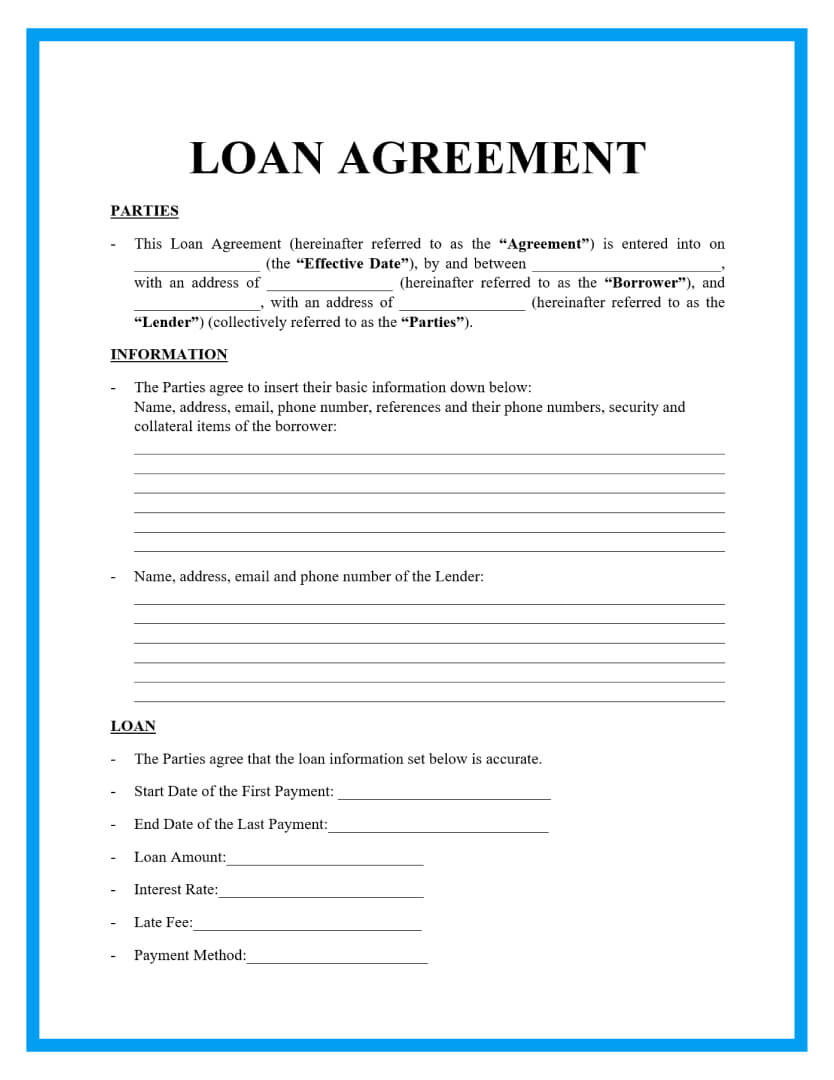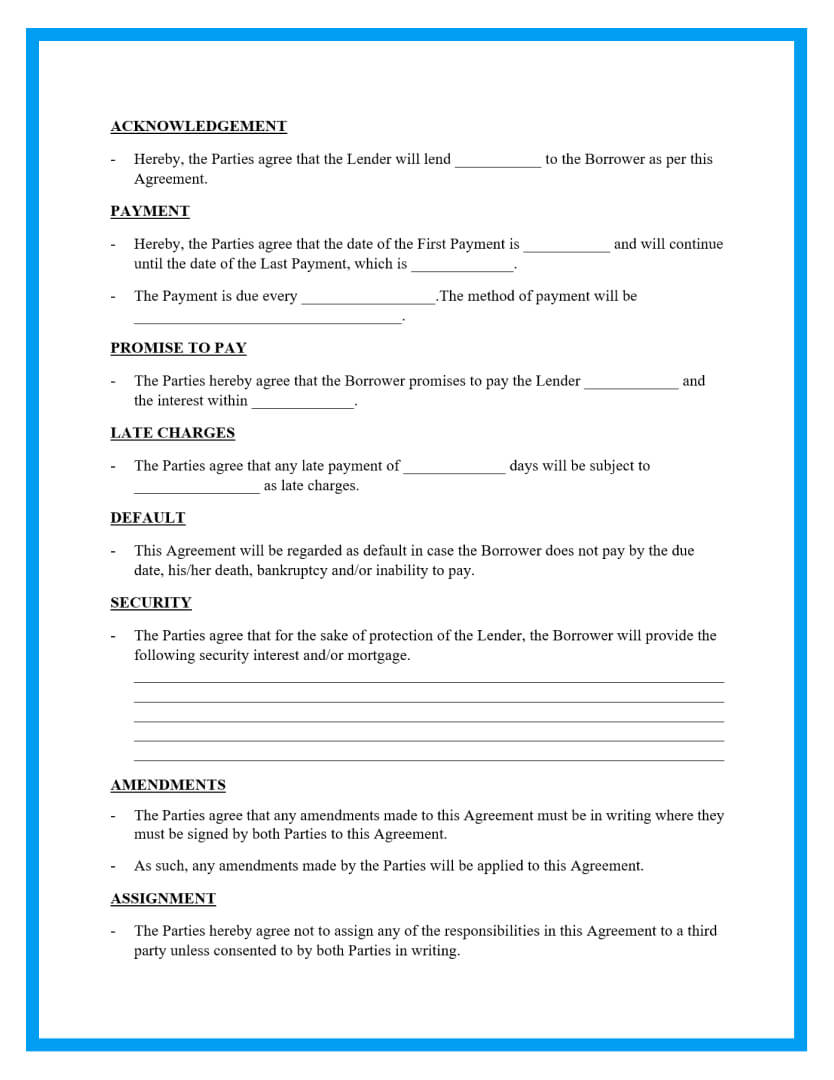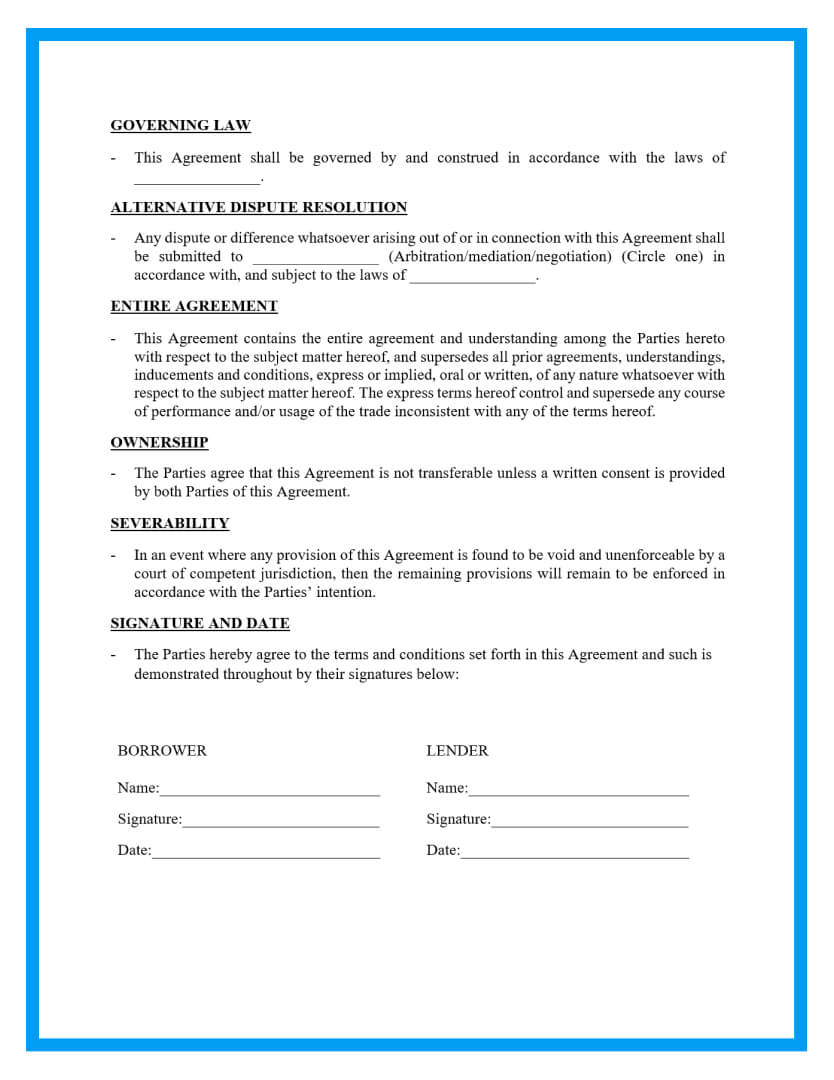
Personal loans are one of the most common financial transactions between stakeholders. That’s why we’ve created a simple loan agreement template (Word and PDF) for you to use repeatedly as you scale your business.



Personal loans are one of the most common financial transactions between stakeholders. That’s why we’ve created a simple loan agreement template (Word and PDF) for you to use repeatedly as you scale your business.
What’s in this template?A loan is where an individual or business entity (the lender) provides funds to another individual or entity (borrower) for an agreed amount in exchange for repayments plus interest.
A loan contract is a legally binding agreement between lenders and borrowers outlining the terms and conditions of the loan, including the principal amount of the loan, the payment schedule, security checks, interest rate, and the length.
Loan agreements are essential to keep lenders and borrowers accountable to what they agreed on. Without a contract, it increases the chances of a deal going astray. For example, a lender may charge more interest to a borrower than what was agreed upon. Or a borrower starts missing repayments without any consequences.
A signed contract mitigates such risks to help all parties to fulfill their responsibilities reasonably.
DISCLAIMER: We are not lawyers or a law firm and we do not provide legal, business or tax advice. We recommend you consult a lawyer or other appropriate professional before using any templates or agreements from this website.
If not managed with care, loan arrangements can escalate to costly disputes. That’s why we’ve developed a personal loan agreement template to help protect all parties in debt-related transactions.
Click below to access our template todayWhether you’re an individual trying to offer financial aid to a friend or a company who’s lending a business partner money, it’s always best practice to use a loan contract template early in your financial dealings.
As soon as a stakeholder asks if they could borrow money, or if you willingly offer to loan funds, it’s time to reference a loan contract.
You may have preliminary discussions to screen your potential borrower about when to repay your loan and on what terms, but don’t go ahead and transfer any money until all parties have reviewed and signed a personal loan agreement.
Presenting your loan agreement form early will help borrowers decide if they’re in a position to enter such an agreement.
Loan agreements can be long and confusing; however, we’ve found that only a handful of components really matter. Let’s look at some examples below.t.
The first step in any quality loan contract is getting the information from both lenders and borrowers in your agreement. This includes details such as name and contacts, and in the case of borrowers, relevant references, and collateral for security.
Accurate details must be captured in your loan agreements, and we recommend all parties refer to primary photographic identification to verify the correct information.
Perhaps the most important part of your loan agreement is documenting the terms of your loan. This means writing down the start date, loan amount, and interest rate.
Your loan terms form the core of your agreement template, as it’s likely to be the most referenced information on your form.
It’s common practice that lenders take the lead and prefill the loan terms as part of their offer to borrowers. That way, it’s up to borrowers to decide whether they are willing to accept those loan terms.
Another crucial element of any loan agreement is stipulating the borrowers’ repayment schedule. Parties need to agree on how and when payments will be made. For example, a lender may decide that repayments are to be made via direct deposit and are due on the 1st of every month.
Of course, these details can be negotiated before signing the contract, in case the borrower has different preferences for payment methods of payment frequency.
The key to a successful loan agreement is ensuring the borrowers make consistent repayments under the contract. If borrowers are unable to adhere to the payment schedule, it’s common that lenders charge a late fee.
Lenders must be clear on when payment becomes late, and how much the penalty is.A loan agreement is not legally binding without written consent from the lender and borrower. Signatures are legal proof that all parties acknowledge and accept the terms of the loan contract.
If not managed with care, loan arrangements can escalate to costly disputes. That’s why we’ve developed a personal loan agreement template to help protect all parties in debt-related transactions.
Click below to access our template today Frequently Asked QuestionsA loan agreement letter is a formal correspondence used by lenders to offer loans to prospective borrowers.
Specifically, a loan agreement letter is a shortened and abbreviated contract summarising the terms of the loan.
A loan contract conversely, is a legally binding agreement that requires signatures from lenders and borrowers.
Lenders, primarily banks and financial institutions, use a combination of a letter and contract depending on their processes.
We suggest you use both documents when engaging with new borrowers, as the letter is a simple summary that’s easy to interpret. At the same time, the contract provides legal proof of the commitments each party has made.
Any agreement can be legally binding if it can be proved that a contract was formed. This could be as simple as a party presenting an offer or promise, and another party accepting those terms.
However, verbal or informal agreements are harder to validate in the court of law, as the nature of the arrangement can be easily discredited. For instance, if you make a verbal arrangement with someone with no witnesses around, it becomes your word versus theirs, nearly impossible to prove.
A written agreement signed by both parties has more substantial grounds for validity in legal proceedings and is why we always recommend using contracts.
– This Loan Agreement (hereinafter referred to as the “Agreement”) is entered into on ______________ (the “Effective Date”), by and between __________________________ , with an address of ______________ (hereinafter referred to as the “Borrower”) and ______________ with an address of ______________ (hereinafter referred to as the “Lender”) (collectively referred to as the “Parties”).
– The Parties agree to insert their basic information down below: Name, address, email, phone number, references and their phone numbers, security and collateral items of the borrower: ____________________________________________________________________________________________________________________________________________________________________________________________________________________________________________________________________________________________________________
– Name, address, email and phone number of the Lender: ____________________________________________________________________________________________________________________________________________________________________________________________________________________________________________________________________________________________________________